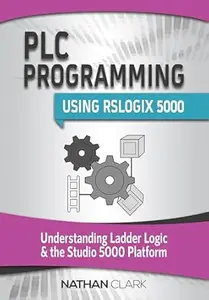PLC Programming Using RSLogix 5000: Understanding Ladder Logic and the Studio 5000 Platform (Allen‑Bradley Automation Book 2)
English | February 15, 2020 | ASIN: B084VBCC5Y | 194 pages | PDF | 13.28 MB
English | February 15, 2020 | ASIN: B084VBCC5Y | 194 pages | PDF | 13.28 MB
Learn How to Design and Build a Program in RSLogix 5000 from Scratch! ★
This book will guide you through your very first steps in the RSLogix 5000 / Studio 5000 environment as well as familiarize you with ladder logic programming. We help you gain a deeper understanding of the RSLogix 5000 interface, the practical methods used to build a PLC program, and how to download your program onto a CompactLogix or ControlLogix PLC. We also cover the basics of ladder logic programming that every beginner should know, and provide ample practical examples to help you gain a better understanding of each topic. By the end of this book you will be able to create a PLC program from start to finish, that can take on any real-world task.
What This Book Offers
Introduction to Ladder Logic Programming
We cover the essentials of what every beginner should know when starting to write their very first program. We also cover the basics of programming with ladder logic, and how ladder logic correlates to the PLC inputs and outputs. These principles are then put to work inside RSLogix 5000, by explaining the basic commands that are required to control a machine.
Introduction to RSLogix 5000 / Studio 5000
We go into meticulous detail on the workings of the Rockwell software, what each window looks like, the elements of each drop-down menu, and how to navigate through the program.
Working with Instructions
We cover every available instruction necessary for beginners, what each instruction does along with a short example for each. You will also learn about communication settings and how to add additional devices to your control system.
Working with Tags, Routines and Faults
We show you how to create and use the various types of tags available, along with all of the different data types that are associated with tags. This guide also covers the finer details of routines, UDTs and AOIs. As well as providing guidance on how to account for typical problems and recover from faults. All of which are essential to most programs.
A Real-World Practical Approach
Throughout the entire guide, we reference practical scenarios where the various aspects we discuss are applied in the real world. We made sure to include numerous examples, as well as two full practical examples, which brings together everything you will have learned in the preceding chapters.
Key Topics
Introduction to RSLogix 5000 and PLCs
Intended Audience
Important Vocabulary
What is RSLogix 5000
What is a PLC
Basic Requirements
Simple Programming Principles
Determine Your Goal
Break Down the Process
Putting It All Together
Basics of Ladder Logic Programming
What is Ladder Logic
XIC and XIO Instructions
OTE, OTL and OTU Instructions
Basic Tools and Setup
Interfacing with RSLogix 5000
Navigation Menus
Quick Access Toolbars
Tagging
Creating New Tags
Default Data Types
Aliasing, Produced and Consumed Tags
Routines, UDTs and AOIs
Creating Routines
User-Defined Data Types
Add-On Instructions
RSLogix Program Instructions
ASCII String Instructions
Bit Instructions
Compare Instructions
Math Instructions
Move Instructions
Program Control Instructions
Communication
Matching IP Addresses
RSLinx Classic
FactoryTalk View Studio
Peripheral Devices
Adding New Modules
Communicating Using Tags
Alarming and Fault Events
Typical Faults
Managing Faults
Practical Examples



